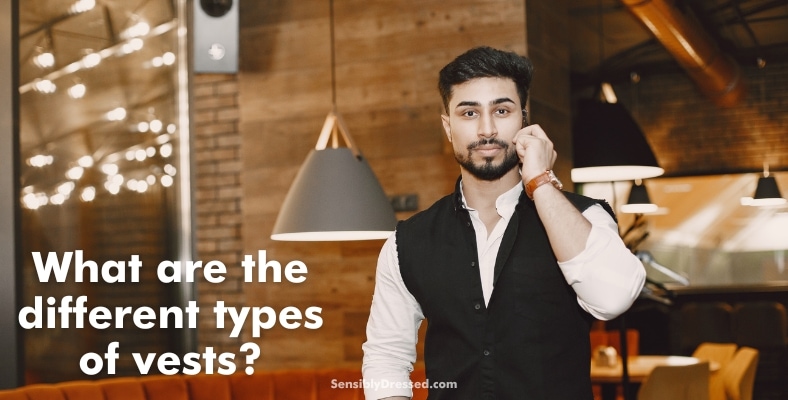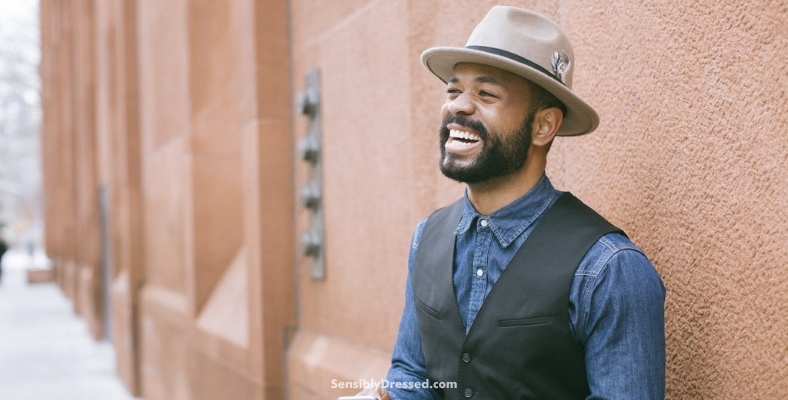Contents
What are the different types of vests?
11 types of vests to know
Woven Vest
The woven vest, or sweater vest, is made from wool yarn or other woven yarn. It can be quite warm as a stand-alone outer garment in lieu of a coat.
It’s a little informal for many occasions but is perfect for a stylish but still casual look. For an even more informal look, an undershirt rather than a shirt can be paired with a woven vest.
A pullover or cardigan sweater can be substituted for a woven vest.
Puffer Vest
The puffer vest is expressly designed for cold weather wear. It’s made from insulated material that is expanded out, giving the entire vest a “puffy” appearance.
The puffer vest is closed with buttons or a zipper. The design of the vest traps heat well, keeping the wearer very warm which is one reason it’s very popular with ski enthusiasts or other outdoor sportsmen.
Puffer vests can also be found with many pockets, making them a good choice for workmen who have to spend a great deal of time outdoors in bad weather.
Fur Vest
Vests can be made of any material, including fur. While fur is generally considered to be a women’s material, this wasn’t always the case historically, and fur vests are now being seen as an elegant, if unusual, part of men’s three-piece suits.
Given that fur is considered a fancy material, it’s not likely that a fur vest will be seen as a choice for men’s casual wear.
The fur used in a fur vest can be either artificial or real.
Either way, fur is quite warm and can be a really good choice in cooler weather – not just a fancy accessory for a blazer.
Gym Vest
The gym vest is an undershirt or vest designed for use during exercise and fitness sessions.
This top is usually made out of a natural material like cotton or a synthetic one like spandex or Lycra. Synthetic material versions are often designed to be light and shed or evaporate moisture easily.
The lack of sleeves helps the wearer move freely and easily while working out. The gym vest is usually designed to stretch and that can also help mobility as well as being a little bit tougher which helps when it’s under stress during hard activity.
Suit Vest
A suit vest is a vest that comes as part of a three-piece suit.
The traditional three-piece suit with a vest is thought of as the most formal of men’s business wear styles. While conventional men’s suits tend towards a few certain drab colors, in recent times, vests have become available in more choices in color, pattern, or fabric.
Without the coat, the vest can be paired with a dress shirt and colored tie. Together with the pants from the suit for a less formal, busy look, especially in the summer and still look very sharp while being less restrictive than a full 3-piece suit.
Tuxedo Vest
Vests can be worn with a tuxedo and black tie, but are optional. The tuxedo can be made of a variety of materials, and the vest can be of a similar or lighter material.
The key decision in selecting a tuxedo vest is not the material, but rather whether to have one at all. If a vest is chosen then a belt or cummerbund is not worn and vice versa.
A vest is mandatory with white-tie formal wear. In this case, the vest is also white. The cut of the vest is the key consideration in this case.
Because a formal coat is often cut high, the vest should not extend beyond the length of the coat front while still covering the waist. If the white vest overlaps the black coat the result will be that the coat looks like it is too small or has shrunk in cleaning.
Denim Vest
A denim vest is a vest made of the same material used to make blue jeans.
Denim is an especially durable and hard-wearing material and so a denim vest can be used either as a work garment or as a stylish but informal article of clothing to be worn with a shirt or blouse.
Although denim can probably be found in any color, blue is by far the most traditional and common. A denim vest can be paired with other articles of denim clothing.
The key to wearing a denim vest and denim jeans or jacket combination is to make sure that the shades of blue of each item are not identical. Otherwise, it can look like a bad attempt at a suit.
Quilted Vest
Quilted vests are designed for cold weather wear. They consist of multiple layers of fabric and insulation often stitched together in pockets in a quilt-like pattern.
The construction results in a garment that is ideal for winter.
While a quilted vest can be made of any material, they’re often made from synthetic fabrics like polyester. The use of a light artificial fabric makes the garment water-resistant and breathable as well as warm and durable.
Fleece Vest
Although the name suggests that this vest is made of wool, the fabric of a fleece vest is almost certainly a variety of polyester. Fleece vests come in a variety of colors, designs, and patterns for both men and women and are usually closed with a zipper rather than buttons.
Since the fleece vest, sometimes simply called a ‘fleece’, is meant for outdoor wear it’s normally worn with a shirt or blouse.
Gilet Vest
A “gilet” vest, sometimes also known as a body warmer, is a sleeveless vest designed to be worn mainly for outdoor work.
A “gilet” vest usually falls to the waist or the knee. It’s also usually plain instead of being decorated and straight-sided rather than fitted to the body. However, in the past embroidered and fitted “gilets” were a lot more common.
Because of its purpose, the “gilet” vest is usually made out of heavier material and can be found in fleece and quilted varieties.
Travel Vest
The travel vest is designed as an aid to the traveler. It’s designed to be worn alone or under a coat or jacket and has a number of interior pockets that the owner can use to hold a passport, money, tickets, and other valuable items.
As such, a travel vest is a remarkably handy article of clothing that can also prevent theft.
Because the travel vest is meant for the practical problems of the traveler, it’s usually made out of heavy, hard-wearing materials that can withstand tough situations and is pretty rugged.
The good news is that you can find them in a variety of styles and colors, but given the reason for purchasing one in the first place, something that stands out a bit less is probably the best choice for you.
What is the difference between a vest and a waistcoat?
The terms “vest” and “waistcoat” both refer to a sleeveless garment that can be worn under a jacket. There are subtle differences between the two terms, although both are often used interchangeably.
- A vest can be worn underneath a jacket with a suit coat but can also be worn separately with no coat for an informal look.
- A waistcoat is usually worn with a formal suit.
- Waistcoats can be either single or double breasted.
- Vests are almost always single breasted.
- A waistcoat sometimes has buttons reaching higher or sometimes even end near the neckline, though not always.
- A vest top button should just match the point of the top button of the coat it is worn with if any.
What do you wear under a vest top?
Vests can be worn in a variety of situations and with a variety of shirts. There are still some good rules of thumb to follow in choosing what to wear with a vest:
- First, try to pick a shirt that is a lighter color than the vest.
- Second, if the shirt is patterned, then you should probably opt for a vest in a solid color.
- Finally, thinner fabrics should be worn under heavier fabrics. (This last rule is not only for fashion but helps you stay comfortable by removing the heavier layer of clothing first.)
Why should you wear a vest?
In addition to providing a layer of clothing to keep the body warmer in cold weather, a vest can add a touch of elegance to an otherwise unremarkable shirt or suit.
The vest can also provide a retro look that’s really hard to beat, hearkening back to the 1940s or earlier. For example, on very formal occasions where a white tie is normal, you’ll need a waistcoat. Similarly, black tie occasions can see vests worn as well.
Vests worn with even a halfway-decent shirt for men or women and some slacks or other nice pants can make a great impression on others even if you can’t afford a 3-piece formal suit or tuxedo.





